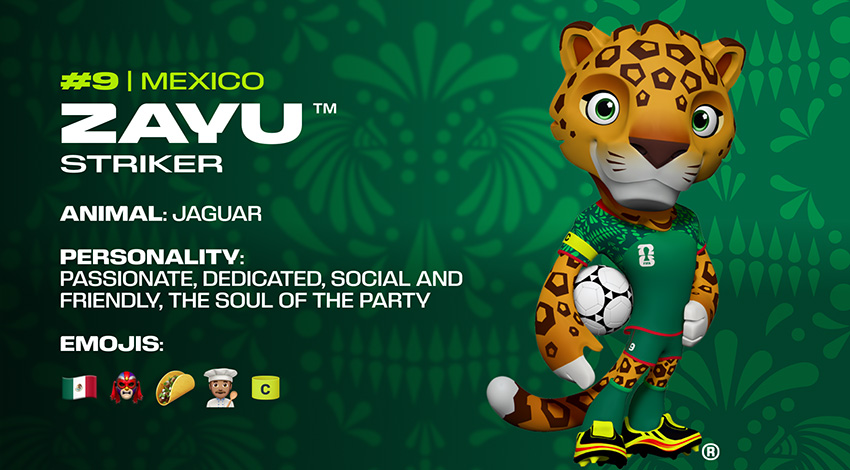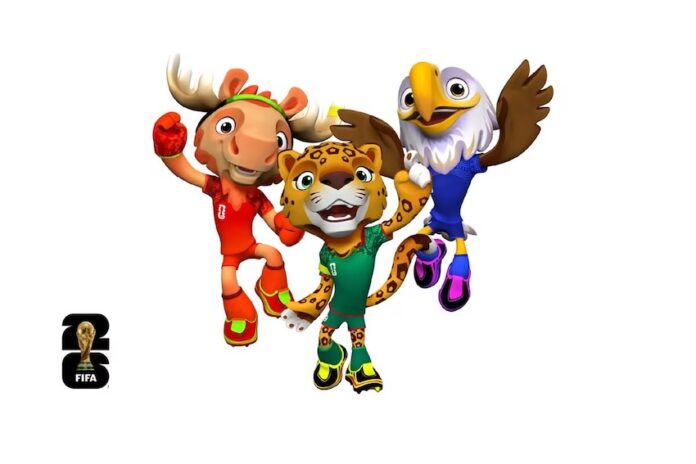More than seven years after Mexico, the U.S. and Canada were jointly awarded the 2026 FIFA World Cup, the mascots for each country have been revealed — and the roar you hear coming from Mexico is that of Zayu the Jaguar.
FIFA, the world governing body of soccer, announced this week that Zayu will join Clutch the Bald Eagle (United States) and Maple the Moose (Canada) in representing the three host countries.

The world’s premier men’s soccer tournament will kick off June 11, 2026 at Mexico City’s Aztec Stadium, renamed as Estadio Banorte in a funding deal. There will be five games in Mexico City, four in Monterrey and four in Zapopan (adjacent to Guadalajara).
Each of the mascots is meant to symbolize national pride, but perhaps the quickest to win over its public — as evidenced by social media engagement and news coverage — is Zayu.
The stocky, smiling jaguar wears Mexico’s green jersey and the number 9.
FIFA says he is “from the jungles of southern Mexico” and that he “embodies the rich heritage and vibrant spirit of the country.” The name Zayu is “inspired by unity, strength and joy.”
Added FIFA President Gianni Infantino: “Maple, Zayu and Clutch convey joy, excitement and the spirit of togetherness that defines the FIFA World Cup. I can already imagine them on children’s jerseys, high-fiving football legends, and, for the first time, starring in video games that millions will enjoy.”
They will be the first mascots to be incorporated as interactive characters in FIFA Heroes, a video game for Nintendo, PlayStation, Xbox and other platforms due out next year.
While officials did not specify a precise linguistic root for Zayu’s name, some Mexican scholars have noted its similarities with Indigenous words such as “Dzahui,” the Mixtec term for rain.
One pro team in Mexico, the Jaguares de Chiapas, celebrated the resemblance between Zaya and its old mascot, Balam, with a posting on Facebook.
Balam was the Jaguares’ mascot from 2002 to 2013 when they played in Mexico’s top-tier Liga MX. The team from the Chiapas capital of Tuxtla Gutiérrez now competes in Liga Premier, Mexico’s third division.
The jaguar has long been a sacred figure in Mexican history: revered by the Maya as a symbol of power and courage, appearing across art and mythology, and still present today as a powerful emblem of southern Mexico.
Mexico’s Ministry of Tourism emphasized that Zayu was selected not merely as a sports figure, but as a cultural bridge carrying centuries of heritage.
This marks the fourth time a feline has served as a World Cup mascot: Spain’s León Willie in 1966, Germany’s Goleo VI in 2006 and Zakumi the leopard in South Africa 2010.
The mascot at the last men’s World Cup, in 2022 in Qatar, was named La’eeb, which means “super-skilled player.” It was supposed to be an animated version of a traditional Arabic headdress, but most people saw it as a ghost.
FIFA bills Zayu as forward, while Canada’s Maple is cast as goalkeeper and Clutch as a midfielder.
Mexican President Claudia Sheinbaum, who was recently presented with the very first 2026 World Cup ticket — which she said she’ll give away, likely to a young girl from a family of meager means who loves soccer — talked over the summer about Mexico’s preparations for the upcoming tournament.
And similar types of stories — including future mascots — won’t be stopping any time soon, as Mexico is expected to co-host the 2031 Women’s World Cup along with the U.S., despite no official announcement yet from FIFA.
With reports from El Universal, Récord, ESPN México and The Athletic
